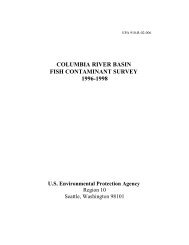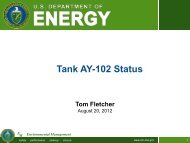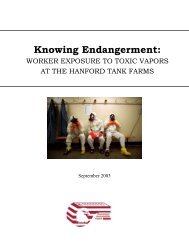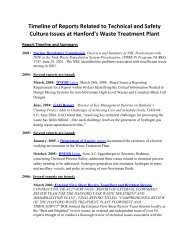Reducing the Risks of High-Level Radioactive Wastes at Hanford
Reducing the Risks of High-Level Radioactive Wastes at Hanford
Reducing the Risks of High-Level Radioactive Wastes at Hanford
Create successful ePaper yourself
Turn your PDF publications into a flip-book with our unique Google optimized e-Paper software.
60 Alvarez<br />
th<strong>at</strong> “few tests appear to be planned to verify safety parameters prior to<br />
construction.” 87,88 NRC’s concluded th<strong>at</strong> DOE and its contractors had sufficient<br />
knowledge and capabilities to mitig<strong>at</strong>e <strong>the</strong> likelihood probability to<br />
1E-4. 89<br />
“Fur<strong>the</strong>r analysis” was required, however, to determine if melter risks could<br />
meet probabilities acceptable under NRC regul<strong>at</strong>ions for reactors and fuel cycle<br />
facilities (10 CFR 70). 90<br />
Based on review <strong>of</strong> <strong>the</strong> nine high-level radioactive waste and several<br />
low-level and mixed waste vitrific<strong>at</strong>ion facilities throughout <strong>the</strong> world, NRCsponsored<br />
research points out th<strong>at</strong> “oper<strong>at</strong>ing limits on chemical composition,<br />
redox control, and glass properties such as viscosity, electrical resistivity, phase<br />
separ<strong>at</strong>ion and liquidious temper<strong>at</strong>ure should be established before start <strong>of</strong> <strong>the</strong><br />
radioactive process.” 91 Failure to meet <strong>the</strong>se conditions have led to serious problems.<br />
For instance, since 1991, <strong>the</strong>re have been eight melter-rel<strong>at</strong>ed incidents<br />
and failures in <strong>the</strong> DOE complex. 92 ,93 (See Table 3.)<br />
On one instance, on 21 April 1996 pressurized steam vented rapidly through<br />
<strong>the</strong> melted glass <strong>the</strong> Oak Ridge low-level, In Situ Vitrific<strong>at</strong>ion (ISV) plant and<br />
caused an explosion th<strong>at</strong> expelled 20,000 kgs <strong>of</strong> glass, spewing hot fragments<br />
over 100 meters from <strong>the</strong> melter site. 94<br />
Of major concern to <strong>the</strong> NRC was th<strong>at</strong>, proposed designs “do not consider<br />
prevention and controls [and] do not include important auxiliary effects in <strong>the</strong><br />
analyses, such as common mode failures, operability, recoverability, and plant<br />
habitability for oper<strong>at</strong>ors” 95 The NRC concluded th<strong>at</strong> “regul<strong>at</strong>ory and safety<br />
issues associ<strong>at</strong>ed with a much larger facility do not appear to have been considered<br />
... On many occasions, <strong>the</strong>re was an implic<strong>at</strong>ion th<strong>at</strong> regul<strong>at</strong>ory reviews<br />
were not allowed to impact cost and schedule ... 96<br />
However, since <strong>the</strong> NRC ended its rel<strong>at</strong>ionship, DOE has taken steps to “reduce<br />
conserv<strong>at</strong>ism” in its high-level waste safety controls <strong>at</strong> <strong>Hanford</strong> to “allow<br />
work to be performed more quickly.” 97 As a result DOE and its contractors<br />
have significantly curtailed safety analyses and oversight, reduced oper<strong>at</strong>ional<br />
safety procedures, and elimin<strong>at</strong>ed DOE approval <strong>of</strong> important changes in safety<br />
analyses and subsequent construction decisions.<br />
Efforts to “reduce conserv<strong>at</strong>ism” have now, however, proven to be costly<br />
and time consuming. In 2003 <strong>the</strong> Defense Nuclear Facility Safety Board took<br />
issue with <strong>the</strong> design assumptions about earthquakes st<strong>at</strong>ing th<strong>at</strong> <strong>the</strong> <strong>Hanford</strong><br />
site could experience destructive seismic activity 15% gre<strong>at</strong>er than California<br />
sites. 98 In March 2005, after subsequent testing, <strong>the</strong> Energy department was<br />
compelled to suspend construction for facilities th<strong>at</strong> would handle a preponderance<br />
<strong>of</strong> wastes and to increase <strong>the</strong> design standard from 20 percent to 40<br />
percent. 99<br />
DOE’s preference for administr<strong>at</strong>ive over engineering controls, because<br />
<strong>the</strong>y cost less is also <strong>of</strong> concern. According to NRC, DOEs approach “appears<br />
to rely extensively on oper<strong>at</strong>or actions to prevent or mitig<strong>at</strong>e <strong>the</strong>







